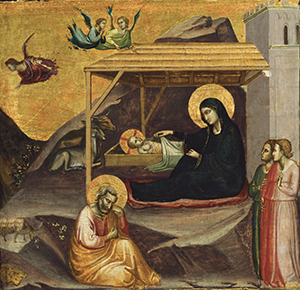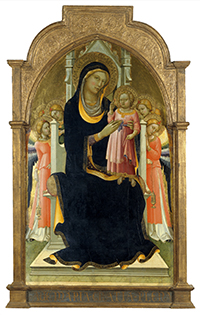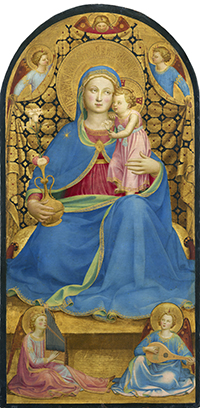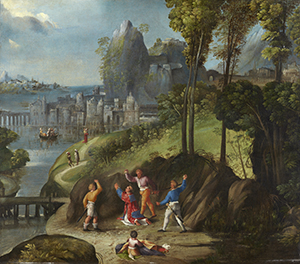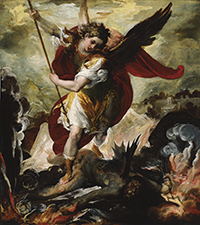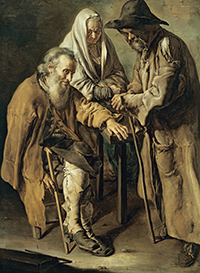Italian painting from the fourteenth to the eighteenth century from Baron Thyssen-Bornemisza’s Collection at the MNAC
When the Museo Thyssen-Bornemisza opened in 1992 an important and representative selection of nearly 80 works of the Italian and German schools was placed on long-term deposit for display at the Monastery of Pedralbes in Barcelona through an agreement reached between Baron Hans Heinrich Thyssen-Bornemisza and the city’s mayor, Pasqual Maragall. In 2004 that group was moved to the Museu Nacional d’Art de Catalunya (MNAC) where it continues to be exhibited today.
To coincide with the commemoration in 2021 of the centenary of the Baron’s birth, ten of these works are now being displayed in Madrid where panels and canvases by artists such as Taddeo Gaddi, Giambattista Piazzetta and Giacomo Ceruti can now be seen in the Old Master paintings galleries of the permanent collection. This selection includes Fra Angelico’s Virgin of Humility, one of the masterpieces of the Thyssen collection and a work that has only been exhibited at the museum on two previous occasions, in 2006 and 2009.
Room 1: Italian Primitives
The exhibition opens with three panels by Bicci di Lorenzo (1373-1452): The Annunciate Angel, The Crucifixion with the Virgin and Saint John and The Annunciate Virgin (ca. 1430), a group formerly in the Somerwell collection in Scotland that may have been part of a polyptich and which remained unpublished until they were auctioned at Sotheby’s in 1970. In 1976 the Baron acquired them for the Thyssen-Bornemisza collection. They are followed by The Nativity (ca. 1325) by Taddeo Gaddi (active ca. 1325-Florence, 1366), a panel possibly painted for a private oratory. Gaddi’s painting reflects both the art of his master Giotto, in whose studio he worked for 24 years, and the innovations that he introduced as he developed his own style. It was probably originally larger and would have included the scene of the Annunciation to the Shepherds as the left-hand side includes a sheep and part of a staff, while an angel is looking in that direction and pointing towards the stable where the principal scene takes place. On deposit with the Museum of Fine Arts in Boston between 1876 and 1977, the painting entered the Thyssen collection in 1979.
Lorenzo Monaco. The Virgin and Child enthroned with six Angels, ca. 1415-1420. Thyssen-Bornemisza Collection, on deposit at the Museu Nacional d'Art de Catalunya (MNAC)
The third work in this gallery is The Virgin and Child enthroned with six Angels (ca. 1415-20) by Lorenzo Monaco (1370/1375-1425/1430), one of the greatest exponents of late Gothic painting in Florence. The panel, which is recorded in a Florentine collection in 1887, passed through various private collections in Scotland and London and that of Rudolf Heinemann before it reached the gallery at Baron Thyssen’s home, the Villa Favorita in Lugano (Switzerland), in 1981. Its dimensions and subject suggest that it was the central element in an altarpiece, flanked by pairs of saints. Monaco’s figures are slim and elongated with gentle expressions, depicted with a palette of bright colours. The artist’s activities as an illuminator are evident in his paintings in the attention to detail and predominance of defined lines. The frame is the original one, albeit with a number of modern additions to the carpentry such as the predella, the lateral columns and the decoration that occupies the upper part of the structure.
Finally, this gallery includes The Nativity and other Episodes from the Childhood of Christ (ca. 1330) by Pietro da Rimini (active between 1315 and 1335), a small panel that was part of a large work dismantled before 1819 of which other elements have been identified in different collections. Da Rimini’s style reflects Byzantine models in the gilded backgrounds and the decorative nature of some details. However, his work also includes innovations, such as the intention to create depth in the scene through the perspectival depiction of the rocky landscape and the quest for realism and communication between the figures in the expressivity of their faces and gestures. Previously in the Dixon collection in Great Britain, the painting was acquired by Baron Thyssen in 1979.
Room 4: 15th-century Italian painting
The Virgin of Humility (ca. 1433-35), a masterpiece by the Dominican monk Fra Angelico (ca. 1395/1400-1455), now becomes the principal work in this gallery devoted to 15th-century Italian painting. Dating from the start of the artist’s mature period, the scene includes numerous symbolic details such as the lilies that refer to Mary’s purity and the red and white roses alluding to Christ’s Passion. In contrast to the frontality and use of gilding typical of the previous century, here Fra Angelico employs a type of light and chromatic range that are characteristically Quattrocento innovations. In addition, the artist employed novel techniques of a type he had already experimented with in other works, such as the use of incising, which helped him to create volume in the draperies. The painting was in the collection of King Leopold I of Belgium and in the Pierpont Morgan collection in New York between 1909 and 1935. In 1935 it was acquired by Baron Thyssen’s father, Heinrich Thyssen-Bornemisza, and was inherited after his death by his daughter, Countess Margit Batthyáni, from whom Baron Hans Heinrich acquired it for his collection in 1986.
Room 6: the Villahermosa Gallery
Dosso and Battista Dossi. The Stoning of Saint Stephen, ca. 1525. Thyssen-Bornemisza Collection, on deposit at the Museu Nacional d'Art de Catalunya (MNAC)
Displayed in this gallery is The Stoning of Saint Stephen (ca. 1525) attributed to the brothers Dosso and Battista Dossi (1490-1541/1542 and 1490/1495-1548, respectively), and The Adoration of the Magi (ca. 1520) by an anonymous artist known as The Master of the Thyssen Adoration who was active in Bavaria and Austria around 1520. The first work combines notable characteristics of two of the most important pictorial schools in the collection: the Italian and Flemish. The landscape evokes the backgrounds depicted by northern European artists, particularly Patinir, while some of the figures recall Italian models by Raphael and Giulio Romano. The second work presents many of the characteristics of the Renaissance-period Danube school and of two of its most important masters, Wolf Huber and Albrecht Altdorfer, from whom this artist derived the treatment of the vegetation, the elongated proportions of the figures and the architectural background.
Room 15: 17th-century Italian painting
The Archangel Michael overthrowing Lucifer (ca. 1656) is an exceptional work within the output of the Baroque painter Francesco Maffei (1605-1660). It is painted on a stone panel and depicts a subject not repeated within the artist’s oeuvre. The Venetian Maffei creates a scene filled with a sense of movement due to his virtuoso depiction of the extended wings and the numerous folds in the Archangel’s cloak. The background is masterfully resolved through the use of loose brushstrokes and an intense interplay of light and shade.
Room 18: 18th-century Italian painting
The display concludes in Room 18 with Group of Beggars (ca. 1737), the earliest work by the Lombard painter Giacomo Ceruti (1698-1767) to enter the collection in 1975; and The Sacrifice of Isaac (ca. 1715), an early work that perfectly summarises the tenebrist style of the Venetian painter Giambattista Piazzetta (1682-1754). Ceruti’s canvas is one of his masterpieces and an outstanding example of his humanistic approach to the depiction of the humblest social classes. For his part Piazzetta modelled the figures with strong contrasts of light and shade, using ochre, brown and grey-brown tones comparable to those employed by Ceruti but with the addition of a touch of intense blue.
